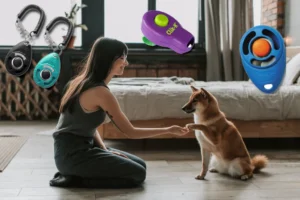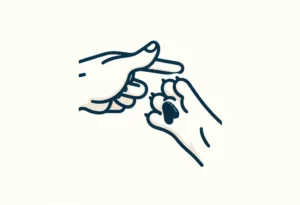Training your dog often feels like trying to solve a Rubik’s Cube with oven mitts on—frustrating and with a high chance of snack breaks. But targeting exercises? They’re the sweet spot of dog training, where success meets fun.
In this post, you’ll discover why teaching your pooch to target can be your new go-to activity for mental stimulation and a happier furry buddy.
Key takeaways:
- Targeting trains your dog to touch a specific object with a body part, creating a fun and foundational skill for more complex commands.
- Essential tools for successful targeting include a target stick, clickers, and treats, yet the ultimate tool is your consistent, positive approach.
- Keep targeting engaging by varying objects and incorporating play, ensuring your dog’s training continues to be an enjoyable bonding experience.
What Is Targeting and Why Should You Teach It to Your Dog?
Targeting is a training technique that involves teaching your dog to touch a specific object with a part of their body, typically their nose or paw. Think of it as giving your pup a “bullseye” to aim for. It’s a foundational skill that serves as a stepping stone to teaching more complicated commands and tricks.
Why is targeting crucial? Targeting enhances the communication lane between you and your furry companion. When your dog understands the concept of touching a specific target, you’ve effectively opened up a whole new method for giving instructions. This can be particularly invaluable for tasks such as closing doors, ringing bells to go outside, or even assisting someone with mobility challenges.
But that’s not all – targeting is more than just a neat party trick. It tunes up your dog’s focus and provides them with a clear goal during training sessions, which can strengthen their overall obedience and responsiveness. So, whether you’re looking to build up from basic training or inject some fun into your routine, targeting is a versatile tool.
How Do You Start Training Your Dog to Target?
Starting off with targeting training can be a breeze if you keep a couple of golden rules in mind: patience and consistency. Here are the initial steps to embark on this journey with your pup:
-
Choose the right target : The target should be something that can hold your dog’s interest, yet isn’t too distracting. It can be as simple as a small piece of tape on the wall or a dedicated target stick with a ball at the end.
-
Introduce the target : Let your dog check out the target without any pressure. You want them to be curious, not fearful or disinterested.
-
Encourage simple touches : Gently coax your dog to touch the target with their nose or paw. Every successful touch should be followed by a reward, whether it’s a treat, affection, or verbal praise.
-
Gradually raise the bar : Once your dog gets the hang of it, start asking for a firmer touch or holding the touch for longer.
Remember, it’s a marathon, not a sprint – rushing through the stages will only confuse your four-legged student. Keep sessions short and sweet, and always end on a positive note. Consistency is key; regular practice will help cement the skill in your dog’s repertoire.
What Tools Do You Need for Target Training?
You might think you need a whole toolbox for target training, but you can often make do with what you already have. However, for those who want to invest in their training sessions, a few specialized tools can come in handy.
-
A Target Stick : Streamlines the targeting process and can be extended to teach your dog to follow directional cues.
-
Clickers : These provide a clear, consistent sound to mark the precise moment your dog does something right, speeding up the learning process.
-
Treats : Never underestimate the power of a delicious reward to motivate your furry friend!
Here comes a nugget of gold that you won’t find in every training manual: use a familiar item your dog loves as a target. This could be their favorite toy, which already has positive associations, making your pooch that much more enthusiastic about targeting it.
Just remember, while gadgets can be nifty, they’re not the be-all and end-all. The most valuable tools are your patience, your dog’s motivation, and the positive reinforcement you provide.
In the end, the right tools will depend on your dog’s personality and your personal training style. Whether you opt for high-tech gear or DIY solutions, the bonding and progress you’ll enjoy with your pooch are what truly matters.
Remember, the aim is to forge an even stronger connection with your canine buddy through effective, enjoyable training. And with these insights, you’re well on your way to mastering the art of targeting with your dog. Keep an eye out for more tips and tricks to turn your training sessions into a tail-wagging success!
How Can Targeting Help with Your Dog’s Other Behaviors?
Targeting isn’t just a standalone trick; it’s a cornerstone for teaching a wide range of commands and behaviors. Think of targeting as the Swiss Army knife in your training toolkit — versatile, handy, and downright essential.
For example, targeting can lead to your dog learning how to push a door close with their nose or paw. Start with targeting the door, and then gradually morph that behavior into a gentle nudge that swings it shut. It’s practical and sure to impress your house guests!
In the realm of agility training, targeting can be a game-changer. Guiding your dog through an obstacle course becomes a breeze when they’re adept at targeting specific points or objects. Essentially, you can direct them around poles, through tunnels, and over jumps with pinpoint accuracy.
Considering various dog sports or advanced training? Targeting forms the basis for tasks in flyball, treibball, and even scent work. Dogs adept at nose-targeting can switch to focusing on specific scents, bolstering their ability to perform in competitions or practical roles like search and rescue.
Can Targeting Solve Specific Behavioral Issues?
Absolutely! Targeting is like a magic wand that can redirect a dog’s focus from negative to positive behaviors. Here’s the skinny:
If you’ve got a jumper, teaching your pup to target your hand can interrupt the jump mid-action, transforming that boundless energy into a calmer greeting.
For the shy or anxious dog, targeting can bolster confidence. A nervous pooch may hesitate to explore new spaces or meet new people. But with targeting as a familiar and fun activity, you can help them associate positives with formerly scary situations. A dog that targets your hand can eventually have the bravery to target a new person’s hand, enabling friendlier interactions.
Finally, targeting can be a lifesaver in emergency situations. Redirect your dog’s attention away from hazards or unwanted animals simply by asking them to target.
Keeping Targeting Fun: How to Keep Your Dog Engaged?
So, you’ve got the targeting basics down pat, but the sparkle in your dog’s eyes is dimming. Time to spice things up and keep that tail wagging! Here are a few nifty ideas to maintain the zest for targeting exercises:
- Switch up the targets. Don’t stick to just one object. Use different shapes, textures, and even movable items like balls to maintain curiosity.
- Create a targeting relay. Set up several targets around the room and have your dog move from one to the other, rewarding them at each stop.
- Make it unpredictable. Randomize when and where you ask for a target so your dog is always on their toes (or paws, rather).
- Incorporate playtime. Finish a session with their favorite game. A round of fetch or tug can be a perfect upbeat ending to targeting practice.
Everyone loves a good surprise, right? Well, dogs do too! One unique tip is to use an unexpected target — like a small sticker on the wall — and pair it with a unique command or cue. This can be especially effective for photo ops when you want your dog to look in a specific direction.
By keeping sessions short and sweet, ending on a high note, and always doling out love and high-value treats, you’ll make targeting the highlight of your dog’s day.
Remember, the goal isn’t just a well-trained dog — it’s a happy, enthusiastic partner who’s always game for the next adventure, be it on a walk or in your living room. Keep at it, stay positive, and enjoy the bonding time. RTVF (Read, train, verify, and have fun!)
Alex, a passionate animal lover, has experience in training and understanding animal behavior. As a proud pet parent to two dogs and three cats, he founded AnimalReport.net to share insights from animal experts and expand his knowledge of the animal kingdom.





